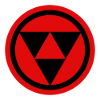The army of the Holy Empire of Man is an organization of vast scale, spreading it’s power across the galaxy. Founded from rebel factions of the Planetary League armed forces, it was taken over by officers loyal to the first emperor, Potus Clarke prior to the start of the Great Reckoning. Through the long millennia of war that followed, the imperial army fought on a continuous basis until the final defeat of the empire in the War of Galactic Unification.
The salute is supposed to resemble a soaring eagle with wings spread.
Because the empire is so gigantic, there are lots of variations in exact designs, but they tend to follow this basic pattern. Enlisted troops usually wear black and white predominately, lower ranked officers tend to have more red in their color schemes, and the upper echelons typically sport at least some gold.
The Chosen, The Penitent, and the Martyrs
The massive war-machine that is Imperial Army is always recruiting fresh soldiers. The Emperor’s glory demands more and more new blood every day. Broadly, these new recruits come from three categories:
The Martyrs are volunteers who sign up to fight. Often they come from the middle echelons of imperial society, and often are trained as officers. They get a salary and some basic benefits. They are the best treated of the emperor’s recruits.
The Penitent are those who owe the empire some debt (real or imagined), and are assigned to (or volunteer for) military service instead of more conventional punishments. They receive little training, and only the necessities of life to keep them fighting, this is made up largely by the fact that they are fighting to gain release from the empire’s atrocious penal system.
The Chosen are conscripts, often chosen from the poor, and any group seen as a minority, or otherwise looked down on. The chosen are used in situations where the number of troops is more important than quality. They often suffer from poor morale, and are the most likely troops to mutiny.









